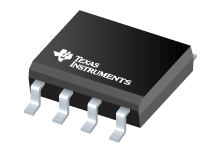Datasheet Texas Instruments TL5001QDG4
| Manufacturer | Texas Instruments |
| Series | TL5001 |
| Part Number | TL5001QDG4 |

PWM Controller with Wide Input Range 8-SOIC
Datasheets
Pulse-Width-Modulation Control Circuits datasheet
PDF, 1.1 Mb, Revision: F, File published: Jan 31, 2002
Extract from the document
Prices
Status
| Lifecycle Status | Active (Recommended for new designs) |
| Manufacture's Sample Availability | Yes |
Packaging
| Pin | 8 |
| Package Type | D |
| Industry STD Term | SOIC |
| JEDEC Code | R-PDSO-G |
| Package QTY | 75 |
| Carrier | SMALL T&R |
| Device Marking | 5001Q |
| Width (mm) | 3.91 |
| Length (mm) | 4.9 |
| Thickness (mm) | 1.58 |
| Pitch (mm) | 1.27 |
| Max Height (mm) | 1.75 |
| Mechanical Data | Download |
Parametrics
| Duty Cycle(Max) | 100 % |
| Iout(Max) | 3 A |
| Iq(Typ) | 1.1 mA |
| Operating Temperature Range | -25 to 85,-40 to 125,-40 to 85 C |
| Package Group | SOIC |
| Rating | Catalog |
| Special Features | N/A |
| Switch Current Limit(Min) | 3 A |
| Switching Frequency(Max) | 400 kHz |
| Switching Frequency(Min) | 50 kHz |
| Topology | Boost,Buck,Flyback,Forward,Inverting,SEPIC |
| Type | Controller |
| Vin(Max) | 40 V |
| Vin(Min) | 3.6 V |
| Vout(Max) | 50 V |
| Vout(Min) | 1 V |
Eco Plan
| RoHS | Compliant |
Design Kits & Evaluation Modules
- Evaluation Modules & Boards: TL5001EVM-097
PWM Buck Controller with Selectable 3.3V or 5V Output
Lifecycle Status: Active (Recommended for new designs)
Application Notes
- Examples Of Applications With The Pulse Width Modulator TL5001PDF, 462 Kb, File published: Jan 1, 1997
Switched-mode techniques are used more and more nowadays for the design of power supplies. Switch mode power supplies have considerably higher efficiency when compared to designs employing linear regulators, and can be used for higher output powers. The rectified input voltage in a switching regulator is chopped by means of a switch. The LC network after the switch smoothes this voltage, resulting - Designing with the TL5001 PWM Controller (Rev. A)PDF, 265 Kb, Revision: A, File published: Sep 1, 1995
Electrical and electronic products required to be lighter, smaller, use less power, and cost less. Manufacturers are turning to small high-frequency dc-to-dc converters for the power supply solution. The TL5001, pulse-width modulator (PWM) control integrated circuit, when combined with a few external components, can implement the converters and operate at frequencies to 400 kHz. This document p - Practical Feedback Loop Analysis for Voltage-Mode Boost ConverterPDF, 559 Kb, File published: Feb 4, 2014
- Off-Line SMPS Failure Modes PWM Switchers and DC-DC ConvertersPDF, 71 Kb, File published: Mar 22, 2000
Today's voltage regulator modules (VRMs) employ off-line SMPS techniques. Traditionally, they are usually discarded when they fail because they are so challenging to debug and so inexpensive to replace. Investigation of these failed modules reveals some common failure modes. Some failures are caused by other systems' passive components that fail after repeated electrical stress. Recognizing these - Understanding Buck Power Stages In Switchmode Power SuppliesPDF, 173 Kb, File published: Mar 4, 1999
A switching power supply consists of the power stage and the control circuit. The power stage performs the basic power conversion from the input voltage to the output voltage and includes switches and the output filter. This report addresses the buck power stage only and does not cover control circuits. Detailed steady-state and small-signal analysis of the buck power stage operating in continuous - Understanding Boost Power Stages In Switchmode Power SuppliesPDF, 149 Kb, File published: Mar 4, 1999
A switching power supply consists of the power stage and the control circuit. The power stage performs the basic power conversion from the input voltage to the output voltage and includes switches and the output filter. This report addresses the boost power stage only and does not cover control circuits. The report includes detailed steady-stage and small-signal analysis of the boost power stage o - Basic Calculation of a Boost Converter's Power Stage (Rev. C)PDF, 186 Kb, Revision: C, File published: Jan 8, 2014
This application note gives the equations to calculate the power stage of a boost converter built with an IC with integrated switch and operating in continuous conduction mode. It is not intended to give details on the functionality of a boost converter (see Reference 1) or how to compensate a converter. See the references at the end of this document if more detail is needed. - Understanding Buck-Boost Power Stages in Switchmode Power Supplies (Rev. A)PDF, 363 Kb, Revision: A, File published: May 28, 2002
Model Line
Series: TL5001 (21)
Manufacturer's Classification
- Semiconductors > Power Management > Non-isolated DC/DC Switching Regulator > Buck/Boost, Inverting or Split-Rail > Buck/Boost or Inverting Controller (External Switch)
